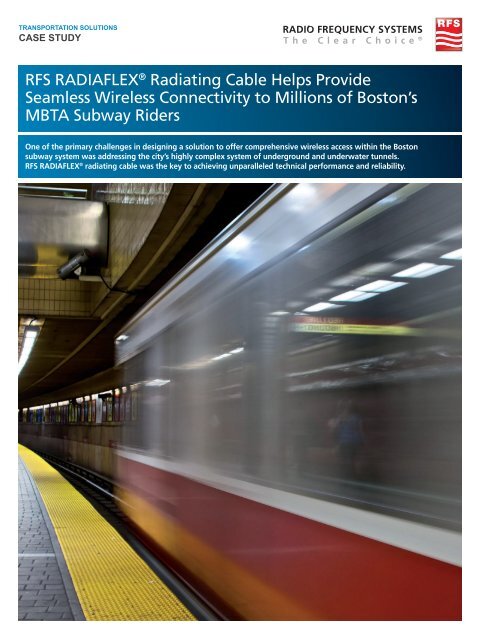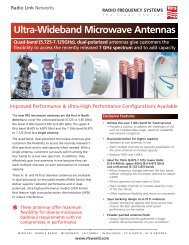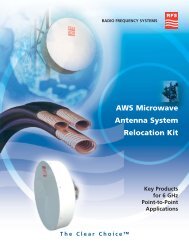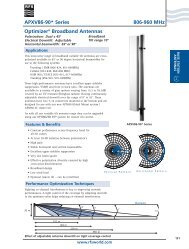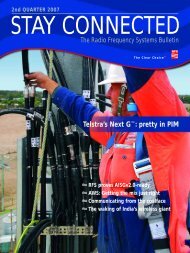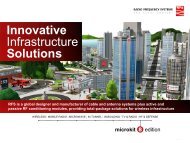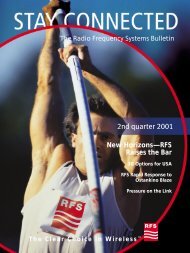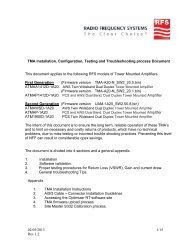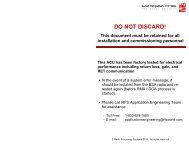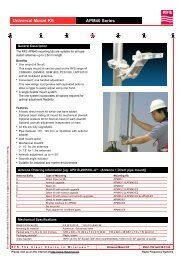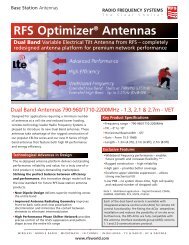RFS RADIAFLEX® Radiating Cable Helps Provide Seamless Wireless
RFS RADIAFLEX® Radiating Cable Helps Provide Seamless Wireless
RFS RADIAFLEX® Radiating Cable Helps Provide Seamless Wireless
Create successful ePaper yourself
Turn your PDF publications into a flip-book with our unique Google optimized e-Paper software.
TRANSPORTATION SOLUTIONS<br />
CASE STUDY<br />
<strong>RFS</strong> RADIAFLEX ® <strong>Radiating</strong> <strong>Cable</strong> <strong>Helps</strong> <strong>Provide</strong><br />
<strong>Seamless</strong> <strong>Wireless</strong> Connectivity to Millions of Boston’s<br />
MBTA Subway Riders<br />
One of the primary challenges in designing a solution to offer comprehensive wireless access within the Boston<br />
subway system was addressing the city’s highly complex system of underground and underwater tunnels.<br />
<strong>RFS</strong> RADIAFLEX ® radiating cable was the key to achieving unparalleled technical performance and reliability.
TRANSPORTATION SOLUTIONS<br />
CASE STUDY<br />
<strong>RFS</strong> RADIAFLEX ® <strong>Radiating</strong> <strong>Cable</strong> <strong>Helps</strong> <strong>Provide</strong> <strong>Seamless</strong> <strong>Wireless</strong><br />
Connectivity to Millions of Boston’s MBTA Subway Riders<br />
The Challenge<br />
During the initial phases of the MBTA<br />
project, which included eight platforms in<br />
four stations all relatively close to each<br />
other (¼ mile apart or less, with relatively<br />
straight paths), InSite was able to use<br />
antennas to provide wireless connectivity.<br />
But as the job progressed, the<br />
environment began to include more<br />
complex environments such as narrow<br />
tunnels, long curves, up and down hill<br />
areas, sections of track under bodies of<br />
water, and more.<br />
The rapid growth of wireless communications has resulted in<br />
today’s transit passengers demanding a seamless wireless experience<br />
for the duration of their commutes. For Boston’s subway riders, this<br />
quality user experience includes being able to use their wireless devices within<br />
the city’s highly complex system of underground and underwater tunnels.<br />
However, the in-tunnel environment is one of the world’s most challenging<br />
from an RF perspective. The twists, turns and constrained cross-sections of<br />
any tunnel, coupled with the large -- and fast-moving -- vehicles it carries,<br />
present an onerous RF distribution challenge. Furthermore, the modern<br />
wireless communications systems that serve transit passengers must also<br />
simultaneously accommodate a wide variety of commercial technologies<br />
from 2G to 3G, 4G and beyond.<br />
As a result of this growing trend, The Massachusetts Bay Transportation<br />
Authority (MBTA), the public transportation system of Greater Boston,<br />
initiated a project to provide continuous, end to end wireless coverage in the<br />
underground stations and tunnels of its transit system. After a public bidding<br />
process, the MBTA awarded a contract to provide and operate a neutral<br />
host wireless distributed antenna system (DAS) in the subway system<br />
to InSite <strong>Wireless</strong>, a company focused on the design, construction, operation,<br />
and maintenance of shared wireless infrastructure for complex indoor and<br />
outdoor environments. InSite specializes in neutral host DAS utilized by<br />
multiple carriers, specifically targeted at customers who seek seamless wireless<br />
coverage in the most challenging of physical environments such as convention<br />
centers, casinos, airports and transit systems, where either the quality of<br />
wireless signals is impaired by building structures or the signal capacity is<br />
insufficient to meet fluctuating occupancies.<br />
Given the nature of<br />
the DAS business, you don’t<br />
want to have to worry about<br />
the technology in place,<br />
so it is critical to have good<br />
components and good<br />
vendors…<br />
Additionally, there were instances where<br />
space to mount the equipment was not<br />
available and/or there was limited signal<br />
propagation. InSite had also reached a<br />
point where it had to work around the<br />
massive flood gates on one of the<br />
system’s Red Line routes. These gates are<br />
large doors that allow the tunnels to be<br />
sealed to prevent water passage during<br />
the construction of highway tunnels.<br />
With all of these factors in play, antennas<br />
were no longer a viable option.<br />
<strong>RFS</strong> CASE STUDY<br />
2
The Solution<br />
InSite engineers had to design a system to<br />
accommodate the varied geometry of the<br />
tunnels and the different types of trains<br />
used on each line, as well as a way to get<br />
past the flood gates without interfering<br />
with their operation. To solve problem<br />
installation areas, the designers specified<br />
RADIAFLEX ® radiating cable from <strong>RFS</strong>.<br />
RADIAFLEX radiating cables facilitate radio<br />
communication where the usual free space<br />
propagation of electromagnetic waves is<br />
hampered, undesired or impossible - in<br />
environments such as tunnels, mines,<br />
buildings, and large complexes like<br />
exhibition grounds or airports.<br />
To work around the flood gates, the InSite<br />
team used existing cable sleeves (used for<br />
electricity wiring and other existing cabling)<br />
to thread the RADIAFLEX cable through the<br />
gates and into the rest of the tunnel –<br />
ensuring seamless wireless service.<br />
Time constraints were also a key issue for<br />
the cable installation process. Due to the<br />
MBTA’s schedule, installers are only able to<br />
work when trains are not running. After<br />
the process of shutting down power, work<br />
trains and other vehicles coming through,<br />
the installers get an average of only 2 to<br />
2.5 hours per night to work.<br />
<strong>Radiating</strong> cable is similar to regular<br />
antenna cable, with slots cut into the outer<br />
conductor that allow the cable to work like<br />
a sprinkler hose and “spray out” low levels<br />
of signal along its entire length. For<br />
example, a single radiating cable extending<br />
1,100-1,500 feet will spread an RF signal<br />
out to serve a long curve.<br />
In this kind of installation process, hi-rail<br />
vehicles (trucks fitted with special train<br />
wheels to allow them to drive on the<br />
tracks) are used to put hangers on the<br />
wall of tunnels, which tend to be<br />
crowded, so installers have to be<br />
extremely careful about where to locate<br />
them. <strong>RFS</strong> RADIAFLEX cables include<br />
numerous features to simplify installation.<br />
To help installers find the correct position,<br />
for example, the RADIAFLEX cable jacket<br />
is equipped with two guides that fit<br />
exactly into the rear open part of <strong>RFS</strong><br />
standard clic clamps or in the open slots<br />
of heavy-duty clamps. This simplification<br />
can be critical under tight time<br />
constraints.<br />
We have found<br />
RADIAFLEX ® to be a<br />
technically superior cable,<br />
and the quality of product<br />
and ease of installation have<br />
been critical factors in our<br />
success<br />
Joe Mullin<br />
Vice President of Engineering and<br />
Operations at InSite <strong>Wireless</strong><br />
Installers had to work around the massive flood gates,<br />
which allow the tunnels to be sealed to prevent water<br />
passage during construction of highway tunnels. Existing<br />
cable sleeves were used to thread RADIAFLEX cable<br />
through the gates and into the rest of the tunnel.<br />
Furthermore, the highest risk for<br />
malfunction, besides cable handling, is<br />
poor installation of connectors. <strong>RFS</strong> onepiece<br />
connectors for radiating cable are<br />
virtually foolproof, further simplifying the<br />
installation process. <strong>RFS</strong> also offers a wide<br />
range of standard and special drums in<br />
order to meet specific project needs.<br />
<strong>RFS</strong> CASE STUDY<br />
3
TRANSPORTATION SOLUTIONS<br />
CASE STUDY<br />
<strong>RFS</strong> RADIAFLEX ® <strong>Radiating</strong> <strong>Cable</strong> <strong>Helps</strong> <strong>Provide</strong> <strong>Seamless</strong> <strong>Wireless</strong> Connectivity<br />
to Millions of Boston’s MBTA Subway Riders<br />
Designing a DAS with Unparalleled Technical<br />
Performance and Reliability – Now and Into the Future<br />
There have been numerous challenges<br />
brought on by the rapid growth in<br />
wireless usage, and the resulting<br />
introduction of new frequency bands.<br />
Whereas connectivity needs were once<br />
adequately served at 800 MHz and<br />
below, technology systems now have to<br />
address a wide variety of frequencies<br />
ranging from 700MHz up to 2700 MHz.<br />
In designing a system<br />
such as the MBTA neutral<br />
host DAS, it is critical to find<br />
a cable that will serve all of<br />
the relevant frequency<br />
ranges efficiently.<br />
RADIAFLEX had the peak<br />
performance we needed,<br />
while covering all of the<br />
required frequencies.<br />
Furthermore, InSite required a radiating<br />
cable solution without stop bands to<br />
accommodate a high-performance,<br />
future-proof design for the MBTA DAS<br />
installation. <strong>RFS</strong> is the only company on<br />
the market with the intellectual property<br />
and leading-edge technology to suppress<br />
stop bands in radiating cables.<br />
The RADIAFLEX suite of radiating cables<br />
feature <strong>RFS</strong>’ patented “higher order<br />
mode suppression technique” that<br />
allows <strong>RFS</strong> to offer cables that support<br />
current and future in-tunnel and inbuilding<br />
commercial and private radio<br />
services from 698 MHz to 2700 MHz for<br />
valuable cost savings. As a result of this<br />
patented higher mode suppression,<br />
selected RADIAFLEX cables have no stop<br />
band from 698-2700 MHz. RADIAFLEX<br />
cables are future-proof with respect to<br />
RF spectrum re-banding / re-farming,<br />
ensure low insertion loss and excellent<br />
coupling performance, and feature<br />
halogen-free, non-corrosive, low-smoke<br />
and flame-retardant jacket material for<br />
safe and reliable long-term cable<br />
operation.<br />
There are a number of<br />
cable manufacturers; the<br />
challenge is finding one that<br />
offers consistent technical<br />
performance and reliability,<br />
while also providing an<br />
economical solution.<br />
<strong>RFS</strong> excelled in all of these<br />
areas.<br />
The periodic repetition of the slot or slot group causes<br />
resonances and harmonics<br />
A single slot or a group<br />
of slots<br />
Is replaced by 2 slots at<br />
specific distance<br />
Each slot is again replaced by<br />
2 slots at specific distance<br />
<strong>RFS</strong> Patented higher mode<br />
supression<br />
The theory behind <strong>RFS</strong>’ higher order mode suppression<br />
technique<br />
<strong>RFS</strong> patented higher mode suppre ssion with no stop bands<br />
<strong>RFS</strong> CASE STUDY<br />
4
Conclusion<br />
To date, InSite <strong>Wireless</strong> has used close to 30,000 feet of<br />
RADIAFLEX cable for the MBTA project, with plans to use<br />
approximately 30,000 feet more in the project’s final phase<br />
of completion. Upon its anticipated 2012 completion, the<br />
MBTA installation will be the first neutral host DAS offering<br />
end-to-end coverage throughout the entire subway —<br />
including 35 underground stations and 19 miles of<br />
connecting tunnels.<br />
T-Mobile currently provides 13 miles of<br />
coverage to 26 underground stops on the<br />
MBTA subway line. As a result, our<br />
customers are now able to carry on<br />
conversations, text and use the Web while<br />
traveling underground in Boston as<br />
seamlessly as they are able to above ground,<br />
with no interruption to their wireless service.<br />
Ensuring this quality user experience for our<br />
customers is critical, and it would not be<br />
possible without the technologically<br />
advanced DAS system installed within the<br />
MBTA subway system.<br />
RADIAFLEX cables include numerous features to simplify installation. <strong>Cable</strong> jackets are equipped<br />
with two guides that fit exactly into the rear open part of <strong>RFS</strong> standard clic clamps, or in the<br />
open slots of heavy-duty clamps, and <strong>RFS</strong> one-piece connectors for radiating cable are virtually<br />
foolproof.<br />
Tom Ellefson<br />
Northeast Vice President of<br />
Engineering at T-Mobile<br />
About InSite <strong>Wireless</strong><br />
InSite <strong>Wireless</strong> specializes in the design, installation, operation, and maintenance of shared wireless infrastructure solutions that<br />
enhance the quality and capacity of wireless voice and data services in public facilities and complex environments. InSite built and<br />
launched its first DAS at the Moscone Center in San Francisco in 2001, and has developed and currently operates additional projects<br />
in convention centers (including the Boston Convention and Exhibit Center), casinos, airports, sports stadiums, and transit systems<br />
like the MBTA subway system. InSite’s parent company, InSite <strong>Wireless</strong> Group, LLC, also owns InSite Towers, LLC, which develops,<br />
manages, and owns nearly 600 telecommunications towers and sites for wireless carriers.<br />
<strong>RFS</strong> CASE STUDY<br />
5
Why <strong>RFS</strong>?<br />
Radio Frequency Systems (<strong>RFS</strong>)<br />
is a global designer and<br />
manufacturer of cable, antenna<br />
and tower systems, plus active<br />
and passive RF conditioning<br />
modules, providing totalpackage<br />
solutions for wireless<br />
outdoor and indoor<br />
infrastructure.<br />
<strong>RFS</strong> serves OEMs, distributors,<br />
system integrators, operators<br />
and installers in the broadcast,<br />
wireless communications, landmobile<br />
and microwave market<br />
sectors. As an ISO compliant<br />
organization with manufacturing<br />
and customer service facilities<br />
that span the globe, <strong>RFS</strong> offers<br />
cutting-edge engineering<br />
capabilities, superior field<br />
support and innovative product<br />
design. <strong>RFS</strong> is a leader in<br />
wireless infrastructure.<br />
For over 35 years, <strong>RFS</strong> has<br />
provided total-turnkey RF<br />
solutions for the world’s metros,<br />
railway and road tunnels. <strong>RFS</strong> is<br />
the globally acknowledged<br />
expert in tunnel RF coverage<br />
systems, with worldwide<br />
experience and know-how<br />
spanning six continents and<br />
many hundreds of installations.<br />
Serious about services<br />
Customers know they can count on <strong>RFS</strong><br />
for comprehensive logistical capabilities,<br />
flawless execution and outstanding technical<br />
skills and support. The company’s dedicated<br />
shipment coordinators, hotline staff and<br />
on-site engineers go well beyond mere<br />
technology, striving to offer tailored<br />
solutions to meet even the most complex<br />
site-engineering and delivery challenges.<br />
<strong>RFS</strong>’ value-added services match the<br />
exact needs of business partners large<br />
and small.<br />
Ever-present quality<br />
guarantee<br />
From design to manufacture, ISO 9001 and<br />
ISO 14001 certification standards encompass<br />
all aspects of <strong>RFS</strong>’ business worldwide. Every<br />
product <strong>RFS</strong> ships has stood up to the most<br />
stringent technical, environmental and<br />
quality control tests, continuously meeting<br />
and surpassing the expectations of a long list<br />
of wireless carriers, transportation and utility<br />
operators, and broadcasters.<br />
<strong>RFS</strong> backs every product bearing its name<br />
with a quality guarantee that is unrivaled in<br />
the market.<br />
A tradition of innovation<br />
For over a century, <strong>RFS</strong> has been at the<br />
forefront of the wireless communication<br />
industry through its unwavering commitment<br />
to design and develop the world’s most<br />
advanced technology in the field. Dedicated<br />
R&D teams, along with a privileged<br />
partnership with Bell Labs, are at the source of<br />
breakthroughs that are ensuring the mobility<br />
of an increasingly wireless world.<br />
<strong>RFS</strong> is at the frontier of wireless technology<br />
innovation, sustaining the boldest ventures to<br />
enhance the way people communicate and live.<br />
A truly global<br />
company<br />
With on-the-ground personnel in more<br />
than 20 countries and on every continent,<br />
<strong>RFS</strong> always delivers on its commitments,<br />
providing a comprehensive range of<br />
premium products, systems and services.<br />
Its clients benefit from all the advantages of<br />
a global supplier, while relying on dedicated<br />
support from <strong>RFS</strong>’ local engineering,<br />
manufacturing and shipping teams.<br />
<strong>RFS</strong>’ products, systems and personnel can be<br />
found in every corner of the planet.<br />
As a global group, <strong>RFS</strong> is committed to<br />
upholding the most stringent environmental,<br />
health and safety standards, and seeks to<br />
integrate green initiatives in every aspect of<br />
its business.<br />
www.rfsworld.com<br />
T h e C l e a r C h o i c e ®


